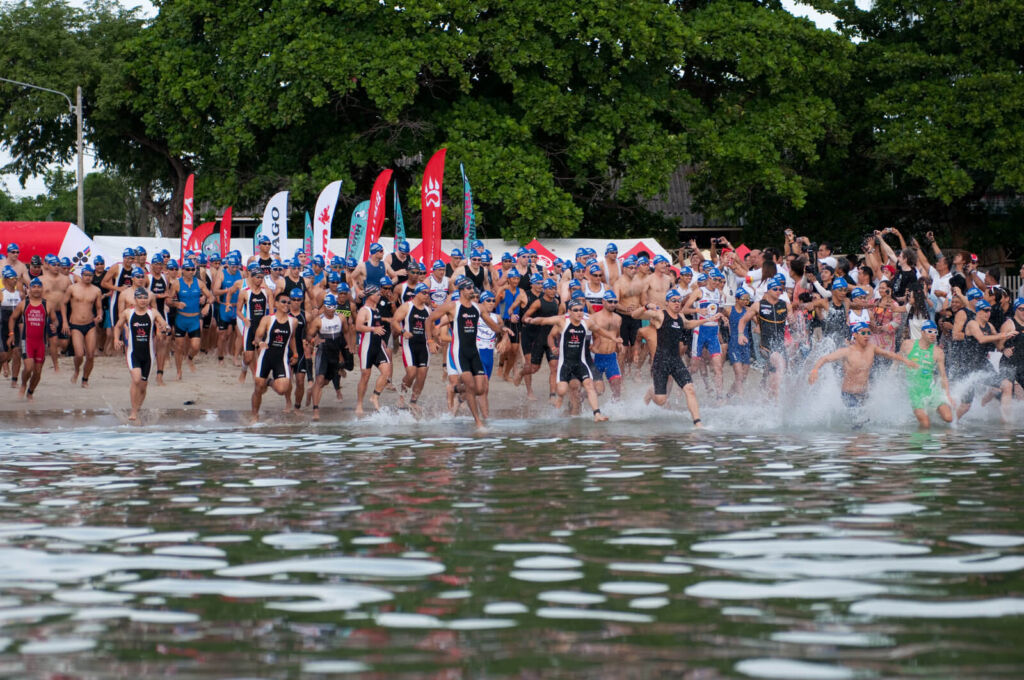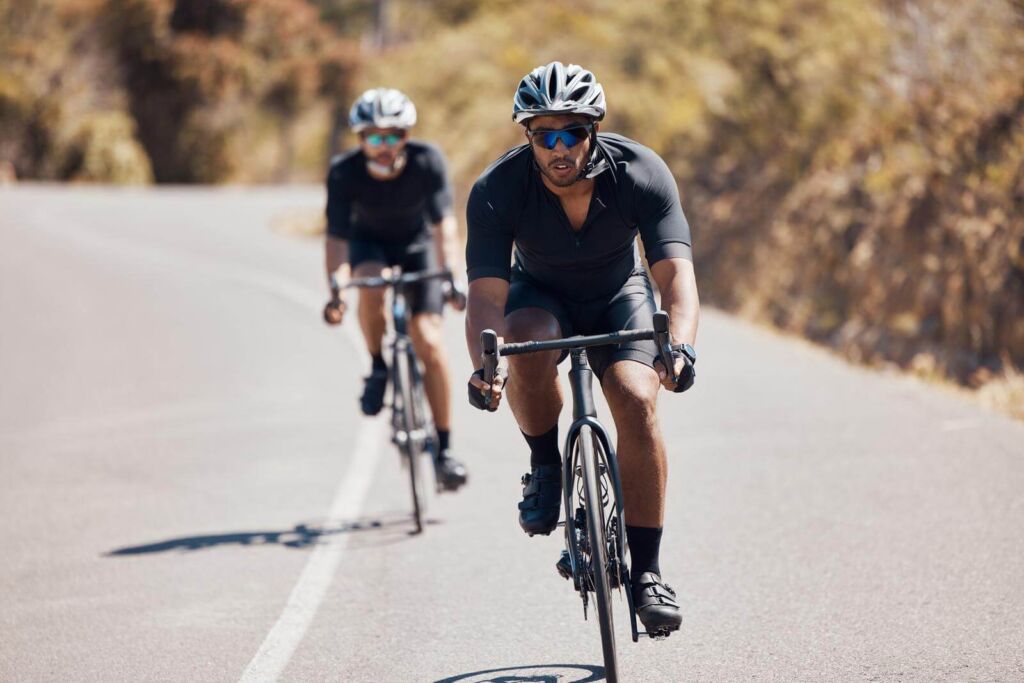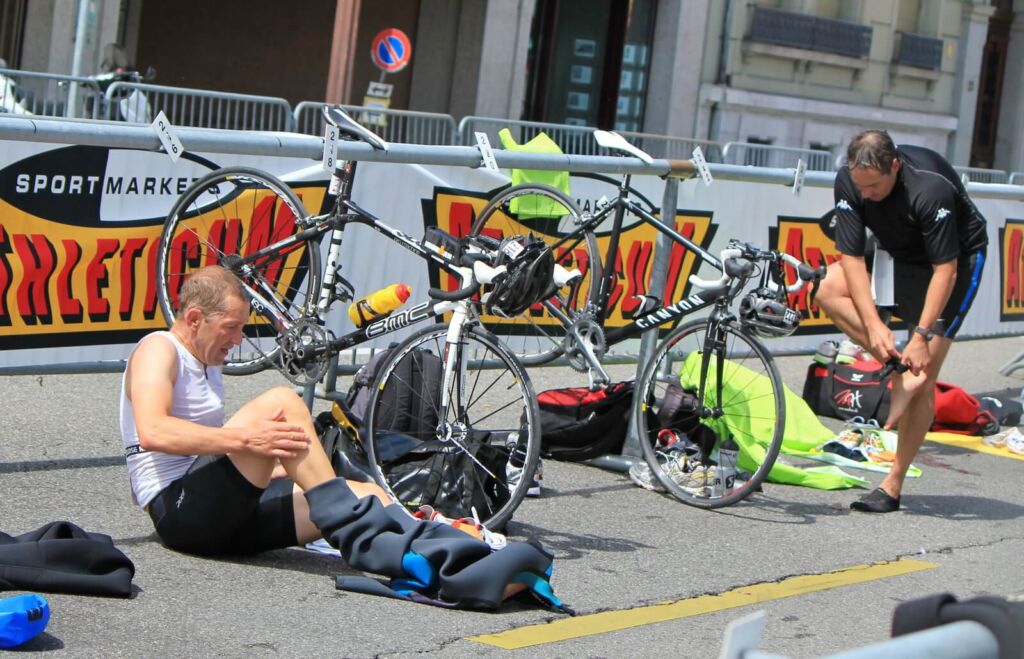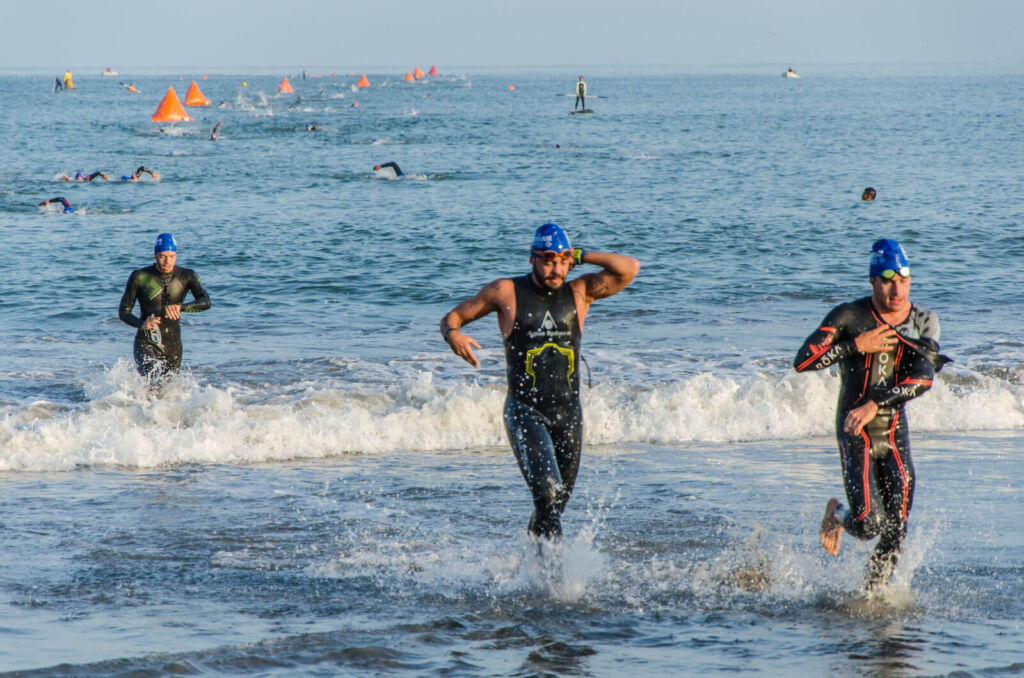Discover what to wear to an Ironman or full Ironman in our guide.
During the summer of 2022, I completed my first half Ironman in Cork, Ireland. Training for the event took me several months and a significant amount of time. But I didn’t factor in how much mental energy the logistics would involve.
For example, I had to figure out what to bring to an Ironman 70.3, what to eat, and allow additional time to buy equipment. Preparing for the event required some planning too. I spent hours researching online and talking to other athletes about it.
If you’re competing in your first Ironman, you’ll need to wear clothing for each of the three disciplines: swimming, cycling and running. Ideally, an athlete tests this clothing during training and doesn’t wear them for the first time in an Ironman event.
Contents
- 1 The Weather
- 2 A Wetsuit
- 3 Flip-Flops
- 4 Goggles
- 5 Padded Bike Shorts Or a Triathlon Suit
- 6 Triathlon Shorts
- 7 Cycling Shoes and Running Shoes
- 8 Gloves
- 9 A Cycling Top
- 10 Sports Socks
- 11 Compression Socks
- 12 Sports Underwear
- 13 Sunglasses
- 14 Headgear
- 15 Calf Sleeves
- 16 Two Pairs of Running Shoes
- 17 A Running Hat
- 18 Towels
- 19 Clothes for Before and After the Event
- 20 Frequently Ask Questions
The Weather
The weather is the most significant determining factor in what you’ll wear to your first Ironman. If it’s hot and humid, pack light, bright moisture-wicking clothing, which protects from the sun, and feels comfortable to wear even when sweaty.
On the other hand, if it’s wet or windy, bring extra clothing that you can change quickly and easily during the transition stages and dries relatively quickly if it rains.
A Wetsuit

Most Ironman events require athletes to wear a wetsuit in the water. The type of wetsuit you’ll wear varies by event and budget. For example, is it entire body or cut off at the elbows and knees?
Picking the right wet suit depends on how warm or cold the water you’re swimming in is. Some Ironman events in warmer countries don’t require athletes to wear a wet suit. Check this with the race organizers. It is easier to swim in a wet case due to buoyancy.
Flip-Flops
Wear a pair of flip-flops or sandals you can use for walking from the changing area to where the spool begins. Best not to wear flip-flops that are too expensive in case you can’t find them or get them back later. That said, I love the Hoka Ora Recovery Slide. To find out why, read our Hoka Ora Recovery Slide review.
Goggles
Pack two pairs in case one breaks. An Ironman usually starts at dawn, so wear a mirrored pair that protects your eyes from the glare of sunrise.
Padded Bike Shorts Or a Triathlon Suit
Most experienced triathletes wear a triathlon suit in the water. A good suit is easy and comfortable to swim in beneath a wetsuit, and it’s quick drying. It provides some cushioning and support for sitting on the bike for hours, and it’s easy to run in.
Running in a traditional cycling suit is a bad idea. It is like running in a wet nappy. That’s because the padding on a conventional cycling suit doesn’t dry after a swim and feels heavy and unwieldy during a run. Similarly, a cyclist isn’t going to sit on a bike for five or six hours in a pair of running shorts, which lacks traditional padding. You can make an exception if you’re prepared to change into one after the swim, with the caveat that it will lengthen your transition times.
Triathlon Shorts
If you don’t want to wear a full triathlon suit, alternatively, another good option is a pair of triathlon shorts. You can put these on under your wetsuit, and they should have some padding, which can protect you during the cycle. Then you can wear a traditional cycling top or a running t-shirt alongside the triathlon shorts.
Cycling Shoes and Running Shoes
You’ll need to wear a pair of cycling shoes to cycle your bike at speed during the event and a good pair of runners for the event. If you’re interested, check out our review of the
Gloves
You’re going to need some gloves for your cycle. If it’s warm, you may only need gloves with the tips cut off, which protect your hands and shoulders from the bumps along the road,
On the other hand, if it’s cold, wear padded gloves to keep your hands and fingers warm, despite the rain and the wind.
A Cycling Top
You can wear a cycling top over a Trisuit. Ideally, it has pockets or compartments for food and drinks that you can easily access during a cycle and run. Alternatively, wear a full triathlon suit; many have compartments for this.
Sports Socks
Pack several pairs. Again, depending on the weather, you may want to wear a warm pair of cycling socks which dry quickly during the cycle. Then when it’s time to transition to the run, either continue to wear these or change into a pair of running socks.
However, if it’s exceptionally hot, avoid woolly socks. Seek a moisture-wicking brand. Otherwise, your feet will start to sweat and be uncomfortable and itchy.
Compression Socks
If you find compression socks help you run long-distance and work well during training, wear them for the run duration of the event. The caveat is they will take longer to put on than traditional socks.
Sports Underwear
A triathlon or Ironman event lasts between six and 12 hours, depending on whether you’re completing a half or a full. That’s a long time to spend wearing underwear that chafes or which is ill-fitting.
Best to invest in a pair of sports underwear, moisture-wicking, or a pair you’ve trained in that feels comfortable to wear for hours at a time. Bring a second pair in case you need to change for some reason on the day, for example, due to an upset stomach.
Sunglasses

No matter the weather, you’ll need a good pair of sunglasses or cycling glasses to wear during the cycle. These glasses protect your eyes from splash-back from other cyclists and the road during wet and windy conditions.
These glasses protect your eyes from the sun beating down on your head if it’s sunny.
Headgear
Aside from a helmet, some triathletes like to wear a bandana or band around their forehead. It helps if sweating is an issue. You’ll, of course, need to wear a helmet to compete in the event safely.
Calf Sleeves
Pack arm sleeves for after the swim if it’s a cold day. Although your body may feel warmed up from swimming, your arms will get cold when stationary on the bike for three-plus hours.
Two Pairs of Running Shoes
Bring a pair of runners that you can wear pre and post-race, which are comfortable to walk in. For example, most carbon plate runners are great to run in during an event, but they’re not something you’re going to walk in. I love the Hoka Rocket X for races. To find out why to, read our Hoka Rocket X review.
A Running Hat
Depending on the weather, wear a moisture-wicking hat, which protects your head and eyes from the sun. If it’s a warm day, wear a moisture-wicking hat, visor or headband that’s light in color rather than dark so you can keep cool. Ideally, this hat dries fast. Nike sells decent variations.
Towels
Pack one towel for each of the transition stages. That way, you can dry yourself after swimming, cycling, and changing pack into regular clothing.
Clothes for Before and After the Event

Ideally, wear comfortable, loose-fitting clothing that you can wear before the event and change out of quickly and easily. For example, wear a tracksuit, tracksuit top, or some type of hoodie.
Bring warm clothes or comfortable clothing that you can change into after the event, which is easy and comfortable to walk around i. Chances are, you will feel exhausted.
Frequently Ask Questions
Do I need a tri suit for an Ironman?
Wearing a triathlon suit to an Ironman saves time when transitioning from each stage. These suits are designed for all three disciplines and dry quickly. However, triathlon suits are not mandatory. You can wear traditional cycling and running shorts and a top, either
Can you wear Airpods during Ironman?
The Ironman even prohibits athletes from wearing AirPods, headsets or earphones due to safety issues. Due to support from the crowd, you won’t need a pair either.



